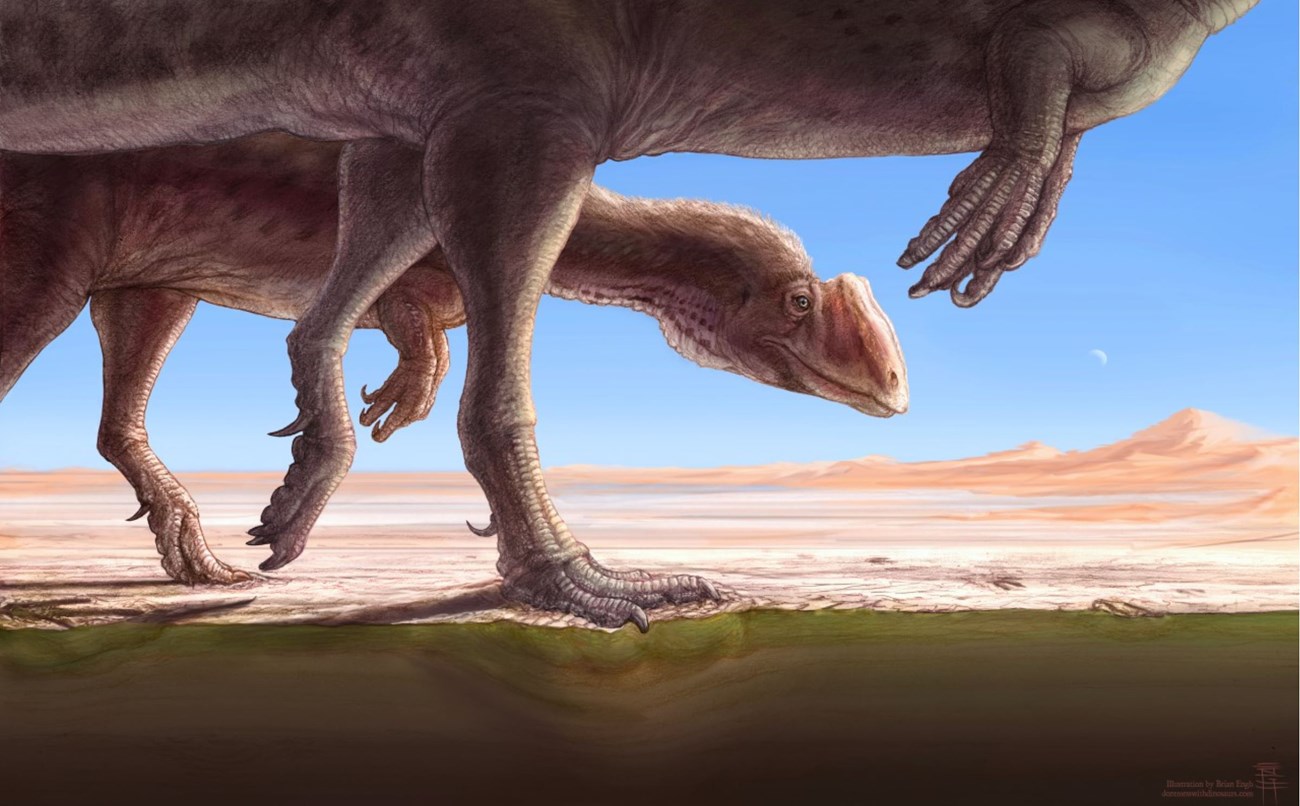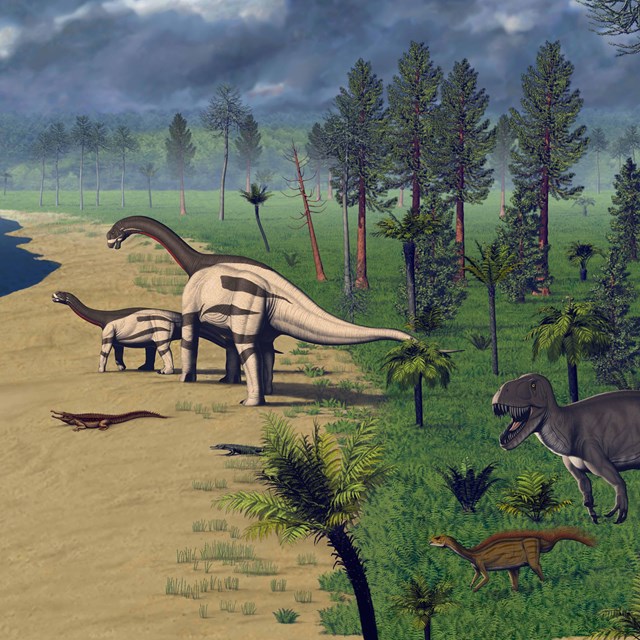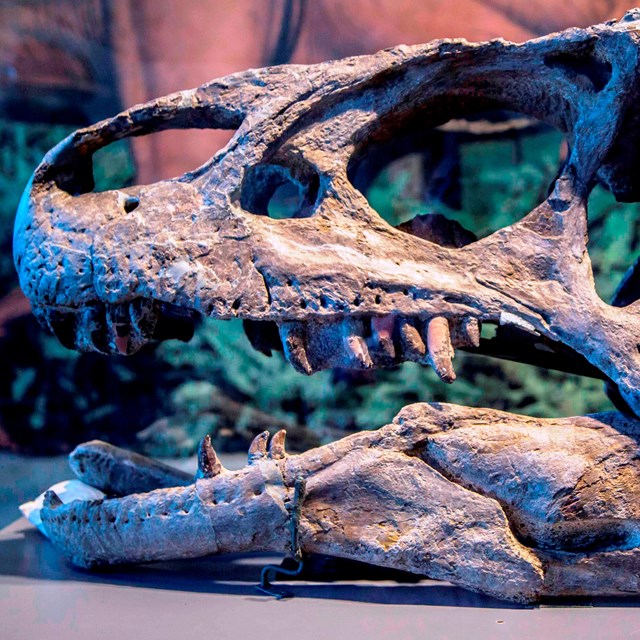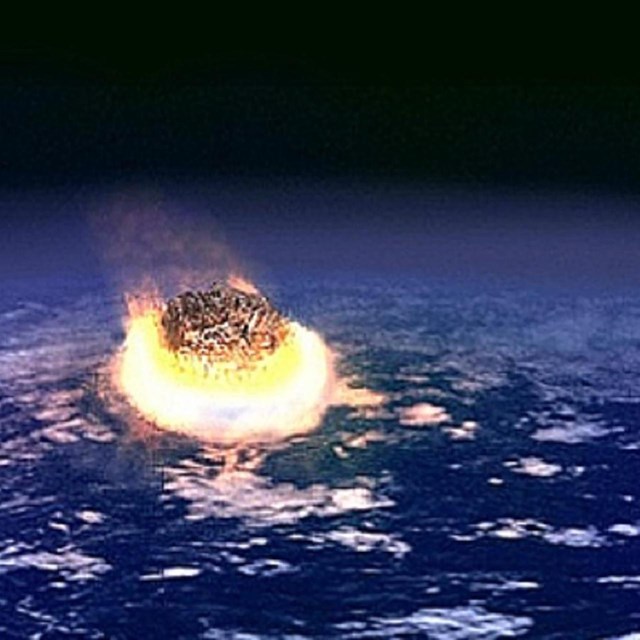
NPS image by paleoartist Brian Engh.
Introduction
The beginning of the Jurassic is marked by rifting between North America and other continents, leading to vast outpourings of lava and the beginning of the Atlantic Ocean. As North America drifted north during the Jurassic, parts of it tracked across arid latitudes that promoted the formation of enormous deserts. Sandstone rocks formed in these deserts contribute to the colorful landscapes of the Colorado Plateau. At other times, shallow seas flooded parts of the West. By the end of the Jurassic, both extremes were replaced by broad floodplains hosting a variety of organisms, including dinosaurs.
Dinosaurs diversified greatly after the extinction at the end of the Triassic removed most of their competition. We have bones and/or footprints of most of the major lineages of dinosaurs dating back to the Early Jurassic: carnivorous theropods; the enormous sauropods with their long necks and long tails; armored dinosaurs, including plated stegosaurs and scute-bearing ankylosaurs; and ornithopods, bipedal beaked herbivores. Dinosaur body fossils are rare in rocks of Early and Middle Jurassic age in North America, but tracks are locally abundant. Although there are some tracks and fossils from New England and the mid-Atlantic states, most North American dinosaur fossils from throughout the Mesozoic come from the western half of the continent. This is simply an accident of geology and geography: the western half of the continent is where rocks of the right age to have dinosaur fossils were deposited and are now exposed.
By the Late Jurassic, conditions were right to preserve large numbers of dinosaur fossils in a rock unit called the Morrison Formation. Many of the most famous dinosaurs of North America are from the Morrison Formation, such as Allosaurus, Apatosaurus, Brontosaurus, Diplodocus, and Stegosaurus. Pterosaurs and mammals diversified, and turtles and crocodiles were also abundant. Birds evolved from a group of small theropod dinosaurs during the Jurassic, but these early birds have not yet been found in North America.
Life and Death in the Jurassic
Meet the Dinosaurs
Jurassic Dinosaurs in Parks
The Jurassic (201 to 145 Ma) record of dinosaurs in the NPS is largely confined to the Colorado Plateau and Yellowstone area. Most finds can be put into one of two categories: tracks from rocks of Early (201 to 174 Ma) or Middle Jurassic age (174 to 163 Ma), or body fossils from the Morrison Formation, of Late Jurassic age (163 to 145 Ma). Jurassic dinosaur tracks have been found in many of the NPS units of the Colorado Plateau, and more are being found every year due to increased interest. These tracks are important because the host rocks have few body fossils, so the tracks are our only evidence of the dinosaurs. Tracks of small to large three-toed predators are most abundant. The Morrison Formation is known worldwide for its fossils of dinosaurs, from predators such as Allosaurus and Ceratosaurus, to enormous sauropods such as Apatosaurus, Brachiosaurus, Brontosaurus, Camarasaurus, and Diplodocus, to the bipedal herbivore Camptosaurus and plated Stegosaurus. The Dinosaur Quarry of Dinosaur National Monument (Colorado and Utah) is one of the most productive dinosaur sites in the Morrison Formation, and has yielded skeletons that are mounted in many museums. Several other parks also have Morrison Formation fossils, mostly in Colorado and Utah, but as far northwest as Yellowstone National Park.
Find Your Park
-
Arches National Park (ARCH), Utah—[ARCH Geodiversity Atlas] [ARCH Park Home]
-
Bighorn Canyon National Recreation Area (BICA), Montana and Wyoming—[BICA Geodiversity Atlas] [BICA Park Home]
-
Canyonlands National Park (CANY), Utah—[CANY Geodiversity Atlas] [CANY Park Home]
-
Capitol Reef National Park (CARE), Utah—[CARE Geodiversity Atlas] [CARE Park Home]
-
Colorado National Monument (COLO), Colorado—[COLO Geodiversity Atlas] [COLO Park Home]
-
Curecanti National Recreation Area (CURE), Colorado—[CURE Geodiversity Atlas] [CURE Park Home]
-
Dinosaur National Monument (DINO), Colorado & Utah—[DINO Geodiversity Atlas] [DINO Park Home]
-
Glen Canyon National Recreation Area (GLCA), Arizona & Utah—[GLCA Geodiversity Atlas] [GLCA Park Home]
-
Katmai National Park (KATM), Alaska—[KATM Geodiversity Atlas] [KATM Park Home]
-
Pipe Springs National Monument (PISP), Arizona—[PISP Geodiversity Atlas] [PISP Park Home]
-
Rainbow Bridge National Monument (RABR), Utah—[RABR Geodiversity Atlas] [RABR Park Home]
-
Springfield Armory National Historic Site (SPAR), Massachusetts—[SPAR Geodiversity Atlas] [SPAR Park Home] (Specimen found at an adjacent site that was part of the armory but is not currently in the park.)
-
Yellowstone National Park (YELL), Idaho, Montana, Wyoming—[YELL Geodiversity Atlas] [YELL Park Home]
-
Zion National Park (ZION), Utah—[ZION Geodiversity Atlas] [ZION Park Home]
National Natural Landmarks—Jurassic Dinosaurs
-
Telling the Dinosaur Story: Part 2 Jurassic
Part 2: Jurassic Period This video is the second in a series about the dinosaur story. Learn about the Jurassic Period, a time when dinosaurs dominated the land and the earliest known birds took to the skies. _ The Telling the Dinosaur Story series explores the fascinating time of dinosaurs as told through various National Natural Landmarks (NNLs) in and along the Rocky Mountain Front.
- Duration:
- 6 minutes, 55 seconds
-
Cleveland-Lloyd Dinosaur Quarry National Natural Landmark, Utah
-
Comb Ridge National Natural Landmark, Arizona
-
Como Bluff National Natural Landmark, Wyoming
-
Dinosaur Trackway National Natural Landmark, Connecticut
-
Garden Park Fossil Area National Natural Landmark, Colorado
-
Morrison-Golden Fossil Areas National Natural Landmark, Colorado
-
Valley of Fire National Natural Landmark, Nevada
National Historic Landmarks
- Quarry Visitor Center National Historic Landmark, Utah
Featured Articles
Site Index and Credits
Age of Dinosaurs (2021)
Text by Justin Tweet (AGI). Contributors: Vincent Santucci (GRD), Adam Marsh (PEFO), ReBecca Hunt-Foster (DINO), Don Corrick (BIBE). Project Lead / Web Development, Jim Wood (GRD).
References
-
Tweet, J.S. and V.L. Santucci. 2018. An Inventory of Non-Avian Dinosaurs from National Park Service Areas. in Lucas, S.G. and Sullivan, R.M., (eds.), Fossil Record 6. New Mexico Museum of Natural History and Science Bulletin 79: 703-730. https://irma.nps.gov/DataStore/Reference/Profile/2257153
-
Santucci, V.L., A. Marsh, W. Parker, D. Chure, and D. Corrick, 2018. “Age of Reptiles”: Uncovering the Mesozoic Fossil Record in three Intermountain national parks. IMR Crossroads. Spring 2018, p. 4-11. https://irma.nps.gov/DataStore/Reference/Profile/2253529
Last updated: May 30, 2023




